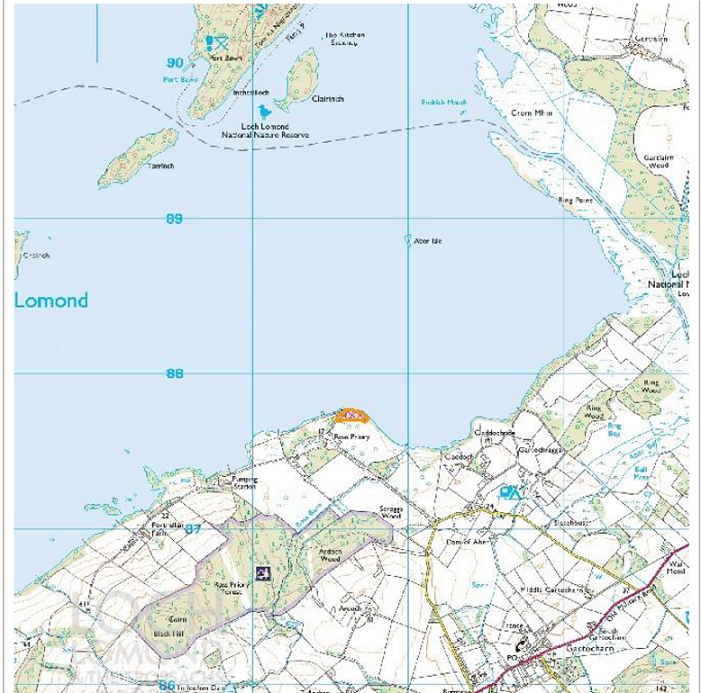
The Planning Application for the Hunter Global Leadership Centre at Ross Priory, which I wrote about in June (see here), is due to be considered by the Loch Lomond and Trossachs National Park Authority on Monday. The Planning Report makes sorry reading and throws any pretence at objectivity to the wind.
As in the case of of the 23 new houses on Luss Estates a year ago (see here), the bulk of the report consists of a convoluted re-interpretation of the LLTNPA’s owned policies so that officers can recommend the development goes ahead. Key aspects of normal planning processes appear to have been subverted. Whether the LLTNPA Planning Committee will be brave enough to challenge the recommendations and flawed decision making process and stand up to Sir Tom Hunter’s Foundation remains to be seen. This post considers the issues and what anyone concerned about the proposed development can do at this late stage.
The subversion of the planning process
“Environmental Impact Assessment (EIA) is a means of drawing together, in a systematic way, an assessment of the likely significant environmental effects arising from a proposed development.” According to the Scottish Government’s Planning Circular 1/2017 (see here) the need for an EIA “will usually be determined by the planning authority based on information to be provided by the developer prior [my emphasis] to the submission of a planning application.” The screening opinion from the LLTNPA stating than an EIA is not required in this case is dated 30th October 2020 and appeared on the planning portal (see here) on 11th November. Had the screening opinion been completed 8 months ago, the requirement for an EIA would have been clear cut as the development was proposing to discharge treated sewerage into the protected waters of Loch Lomond, a significant environmental impact.
The retrospective Screening Opinion is full of errors and omissions. The proposed development, at the end of a small country road on the shore of Loch Lomond, is described for the purposes of the EIA Regulations as “Infrastructure projects (b) Urban development projects”. A more appropriate category from the regulations would be from 12 c) “Holiday villages and hotel complexes outside urban areas and associated developments”. Under the assessment of wildlife impacts, Osprey are not mentioned, even though the Committee Report, published a day later on the 12th November, includes a paragraph dismissing concerns about the pair of osprey that nested near the proposed development this year.
There’s lot more. The point is there should have been an EIA and without one the whole planning process that has led to LLTNPA recommending the application be approved is fundamentally flawed.
Following that serious procedural error, incredible as it may seem, the LLTNPA has produced their Committee Report before the consultation on the revised application has been completed:
5. CONSULTATIONS AND REPRESENTATIONS The application was first consulted upon in March 2020. Discussions with the applicant followed, which culminated in receipt of amended plans and information (comprising a Travel Plan, revised drainage strategy to connect to the public sewer and an amended Landscape Plan with additional tree planting). A re-consultation was undertaken on 30 October 2020 running until the 20 November. As the re-consultation is still live at the time of writing, any responses received after the publication of this report will be notified to the planning committee at the meeting.
This stinks. Planning Authorities are supposed to objectively consider all representations made to them, but in this case LLTNPA officers have clearly already made up their mind and nothing anyone says will count. That the LLTNPA believes new representations could be objectively decided on the hoof in a meeting beggars belief. A perfect example of this is provided by the objection lodged by the Architectural Society of Scotland on 18th November (see here) which, as well as questioning the need for the development, raises serious design issues:
“The accommodation pods though are very different and aggressively brutalistic. Although clad in
timber, their form and almost black colour is quite unacceptable. We see no reason for this.”
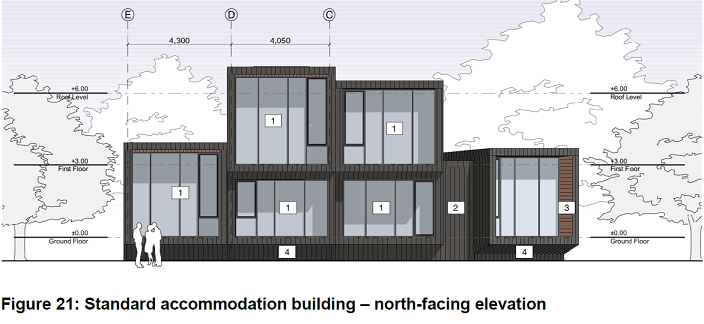
Contrast the views of these architectural experts with the claim in the LLTNPA planning report that:
“The design approach takes full cognisance of its sensitive loch shore and heritage context.”
This example alone shows why the decision to complete the report for the Planning Committee before the consultation was complete is fundamentally unsound.
The subversion of due process goes deeper than that, however, because there is NOTHING on the planning portal alerting the general public that a further round of consultation has been required because of significant changes to the proposed plans or what the closing date for that consultation might be. Unless you read the Committee Report you would never know that the application is open to comments until tomorrow.
As for objectivity, the report simply takes the claims of the consultants working for the Hunter Foundation and presents these as facts:
“The main building would be no ordinary building, the applicant stating it would be a world-class architectural icon befitting Loch Lomond’s outstanding scenic beauty.”
The conclusion, “no ordinary building”, is based on a claim from the applicant. This is worse than spin, it appears designed to deceive. There are many other examples of such flawed reasoning. I particularly liked this one: “Significant weight is applied to the expertise and responses of NatureScot (formerly SNH),…………….”.
And the response of NatureScot?
“SNH does not intend to offer formal comment on this proposal as SNH do not provide advice on landscape including NSA designations and no longer offer bespoke advice to routine protected species issues. SNH now fulfil their advisory role on protected species through the provision of standing advice and do not expect to be consulted except in exceptional circumstances”.
The principle of development
The issue at stake is the very future of Loch Lomond as an undeveloped landscape. The loch is at present is subject to significant development pressures on its southern and western sides: Flamingo Land, the expansion of Cameron House, Moulsdale’s proposals to develop Tarbet, Transport Scotland’s plans to upgrade the A82, the proposal for a chalet park at Ardlui. Within this context, the shoreline between Balloch and Balmaha is particularly important. It is still almost entirely free from development and there was nothing in the LLTNPA’s Local Development Plan proposing that that should change.
It is, however, precisely because the south shore is undeveloped that it is so attractive to the Hunter Foundation (THF):
“THF has chosen to locate the HGLC [Hunter Global Leadership Centre] on the southern banks of Loch Lomond at Ross Priory; one of Scotland’s best vistas.”
“A remote location and quiet environment in beautiful surroundings is absolutely essential to the successful delivery and impact of all our Leadership Academies. … ”
THF is buying exclusive right to a view, one which is free to everyone at present to enjoy from outside, in order to turn this into something to be enjoyed by an elite set sitting behind picture windows or strolling round a designer garden. In doing so, it is also proposing to change fundamentally the nature of that landscape, from undeveloped to developed. Part of the justification for creating the LLTNPA was precisely to stop such things happening, to conserve the landscape and enable it to be enjoyed by all.
The Committee Report, after acknowledging that the proposed development “cannot be easily matched to the LDP’s policies” – an indication that it should never have been allowed to get this far – then stretches the meaning of those polices beyond any reasonable interpretation in order to recommend the development goes ahead. Here is what the LDP says about economic developments in the countryside:
“Development proposals in the countryside for new or expanded businesses uses which support
economic activity shall be supported, provided proposals can demonstrate that there is reasonable justification why they cannot be located within Economic Development Sites as shown within town and village maps; and where the proposal;
(a) Involves home-working or live-work units from an existing residential property, or
(b) Is located within an identified Rural Activity Area or supports priorities identified within the
Buchanan South or West Loch Lomondside Rural Development Frameworks, or
(c) Utilises redundant structurally sound traditional buildings, or
(d) Forms part of a building group where it can be demonstrated that there is a justification for the
business to be located in a countryside location and there are no available sites within towns and
villages, or
(e) Redevelops land which has been identified as vacant or derelict within the associated land
audit.
Economic Development may be supported in some instances where this forms part of a long term farm or estate-wide business management plan.
None of points (a) to (e) apply so the Committee Report justifies the development as being part of an estate-wide business management plan. NO such business plan has been produced. Instead the Vice-principal of Strathclyde University, which owns Ross Priory and the site, has provided a vague letter of support. In the absence of a business management plan, the claims in the report that “the proposal is fundamentally linked to the future management and viability of Ross Priory” remain unsubstantiated and the LLTNPA is breaching its own policy. THF is now apparently offering to “commit circa £20K per annum, subject to profits, in supporting the Estate”. No sane person would base a business plan on that.
The LLTNPA’s consideration of the proposal against its proposals on tourism are similarly flawed. Again the LLTNPA has is a presumption against medium and large scale tourist developments in the countryside unless there is demand for this. The report admits no evidence has been produced to establish any demand but instead claims there is a gap in the market for “leadership centres” before concluding that “Ultimately the demand for such a facility…………….is evident in the substantial c. £10m commitment by THF – an established national charity – to this development”. On this argument any development could be justified on the grounds that the developer is going to invest money.
What’s changed about the application?
There have been a number of significant changes to the application since I covered it in June (link above).
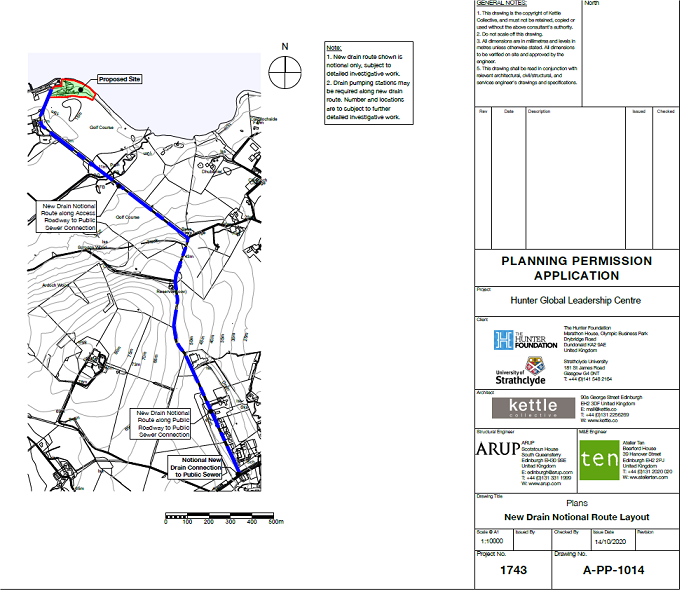
The first is the proposal that treated sewerage should be pumped into Loch Lomond has been replaced by one to dig a pipeline 1.6 km up the hill to the Gartocharn sewerage treatment works. While Scottish Water believe that there is sufficient capacity for the additional sewerage, many local residents have serious doubts about this based on their experience. Proper consultation would have allowed time for these issues to be investigated. Even if resolved, while better than pumping effluent out into the loch, a new sewerage pipeline would increase other environmental impacts of the proposed development (energy consumption, disturbance of ground etc). Its begs the question, in what sense can even medium sized developments in remote places be said to be sustainable?
That question is also raised by a second new document, a travel plan. This, like the travel plan for Cameron House, is full of words about encouraging visitors to arrive by means other than car. These are then undermined by the proposals to provide 23 new parking places for a development that comprises just 19 rooms for overnight accommodation. It appears THF envisages that even couples sharing rooms will arrive separately. If THF were serious about their intention to provide minibuses to ferry people from Balloch Station, they wouldn’t need these parking places. The issue is the rich, who proportionately consume far more carbon than the rest of us, feel entitled to travel by car:
“Up to 4 special guests/speakers would be invited to speak at the Global Leadership Event.
Special guests are to be collected in Glasgow in 2 cars, arriving on site between 16:00-17:00,
departing between 10:00-12:00 the following day”
After jetting in no doubt. Global leaders need, like the rest of us, to start meeting more by zoom. The LLTNPA appears incapable of acting on its statutory duties to prevent global warming but instead in the report justifies the development as filling a global gap. This will inevitably entail more carbon emissions. Never mind, once those leaders arrive, the LLTNPA could always take them off to view some examples of peatbog restoration in the National Park and explain how these will absorb a small proportion of the carbon they are emitting.
The third change is that far more trees are now proposed than in the original plans:
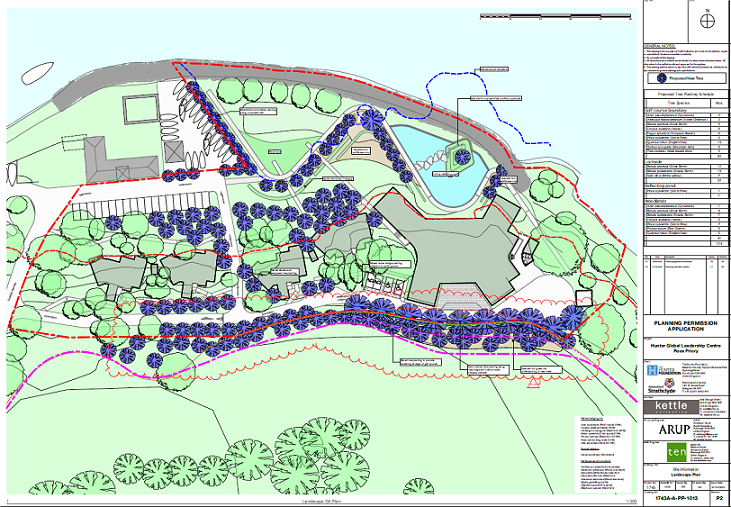
Tree planting, along with polluting plastic tubes, has become the means by which any development is now justified. Additional planting is now being proposed to help screen the Leadership Centre from Ross Priory and its designated landscape in winter and to screen the buildings from the loch year round. That provides proof that, contrary to the claims of the Landscape Visual Impact Assessment, this development could have an enormous impact on the landscape. People should be sceptical about the tree planting plans. If world class vistas are the raison d’etre for locating the HGLC on the shore by Ross Priory, how come THF has now agreed to block most of those views with trees? If approved, expect any requirements to plant trees in front of the development to be met by bonzai pine.
A fourth change is that THF now appear to be promising to invest a little money into Ross Priory and the local area, though the extent of this is far from clear. Besides contributing up to £20k a year if they make profits, there is the £4k a year they had previously promised to the local school and now £150,000 for the specific purposes of delivering the urgent repairs and enhancements to the neighbouring stable block, piggery and bothy buildings “to ensure they are preserved for the future”. While it is welcome that this investment will be secured by a Section 75 agreement it rather begs the question why the restoration of these neighbouring listed buildings was not included in the planning application? In the absence of an estate management plan, the detail of what LLTNPA may have agreed with THF and whether this will actually save the buildings, is unclear.
A fifth change is that statements in the revised plan about high security guests raise implications for the ability of others, including local residents, to enjoy the area:
“Special guests that require high security however would be accommodated at Ross Priory, exclusively using the entire building for the high security guests themselves as well as their security entourage. Ross Priory car park would be used for security entourage. In the event that Ross Priory is to be used for high security guests, other guests would be booked out to local B&Bs as required”.
It seems inconceivable that security for such guests – THF has mooted Barack Obama – would only affect the Ross Priory building. It would have to cover the surrounding area. The implications of this have not been considered, either in the Scoping Opinion, which claims people’s ability to use the land will be unaffected, or in the main report.
And finally, the height of building appears to have been raised slightly to enable it to be cantilevered out across the highest predicted flood levels, so removing another obstacle to development.
Support for and opposition to the development
There has been very little support for the development but well over 40 objections, including Kilmaronock Community Council and a significant number of local residents.
The supporters sadly include the Friends of Loch Lomond and Trossachs (I am an inactive member) who appear, when it comes to development, to have lost sight of the reasons why they were set up. Their website still says they are supported by Optical Express, owned by David Moulsdale, who is described as a friend of Tom Hunter and was bailed out by him in 2013 (see here). The Friends, who in their response describe themselves as independent, have their offices in the LLTNPA HQ. They are, unfortunately, far too close to both business and the planners.
Apart from Strathclyde University, the other supporter is the Rev Iain Miller, the father of Andy Miller, the man employed by Flamingo Land to promote the development of that name at Balloch. Despite the tangled web of connections between developers around Loch Lomond, that may be just coincidence as the Rev Miller’s contribution is written in the best traditions of church support for the rich and famous. It’s worth a read, here is a sample:

It’s hardly surprising that the list of reasons in the Committee Report as to why people supported the Planning Application is very short. By contrast the list of arguments against the development given in the report is far more extensive and, reading them, it is evident that they based on evidence and sound reasoning and emotions equal to those of the Rev Miller. I am afraid, however, that rationality and principle matters little in the planning system, it is who you are that counts.
The Hunter Foundation
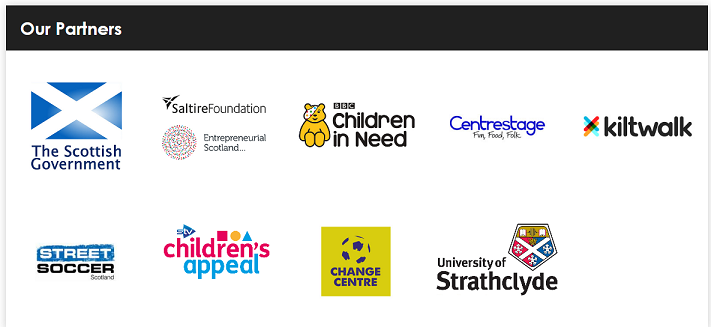
If you are wondering why there has been almost no publicity in the national media about this Planning Application it is not for the want of local people trying. As soon as the media hear that Sir Tom Hunter, one of Scotland’s greatest philanthropists is involved, mysteriously all interest in the story disappears (almost half a million is at stake for the managers at the BBC).
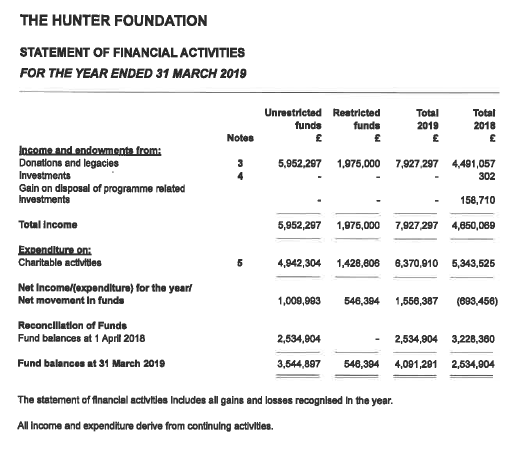 Note 20 to the accounts shows that in 2019 £5,413,777 of the unrestricted income, before gift aid is taken account of, came from the Trustees, who include Sir Tom Hunter and his wife.
Note 20 to the accounts shows that in 2019 £5,413,777 of the unrestricted income, before gift aid is taken account of, came from the Trustees, who include Sir Tom Hunter and his wife.
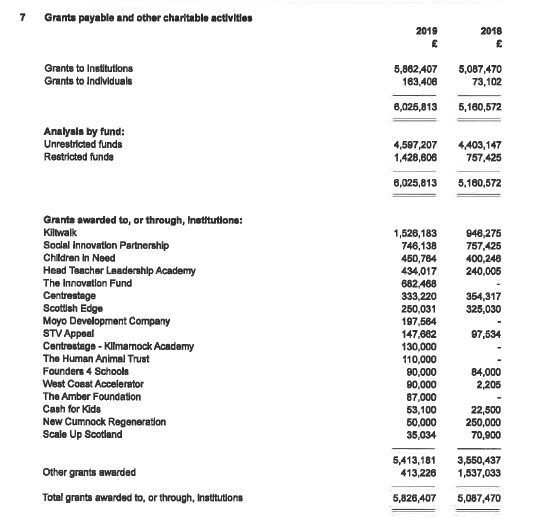
Sir Tom and his wife appear to be disbursing significant sums of money to charities but that should not make this development right. It should be judged by its own merits. The LLTNPA appears, however, to have been bowled over by fame, power and perceived worthiness, and lost all sight of why it was created:
“This proposal is not a commercial venture but one which genuinely aims to promote leadership as the foundation for delivering social and educational advancement in society for the benefit of present and future generations.”
“clearly a genuine, and hugely beneficial proposal for the National Park and Scotland in the long term”
No-one has asked the teachers and the poor who are supposed to benefit from THF’s leadership, whether they want such a centre, whether they think it is appropriate in this location or whether they believe it is compatible with the LLTNPA’s statutory duties to promote conservation, sustainable development and people’s ability to enjoy the countryside.
What needs to happen
If the Planning Committee are reluctant re-start the whole flawed planning process on Monday, they could still re-assert the importance of the LLTNPA’s policies for determining decisions, clearly state that development in certain areas is unacceptable and direct the Hunter Foundation towards one of the derelict sites at Tarbet and Arrochar which have been identified for development. If the view there isn’t good enough for THF, so be it. They can always go and look for somewhere else outwith a National Park.
At the end of their report the LLTNPA refer to some of their exceptions they have made in the last 20 years to allow developments to go ahead in some of Scotland’s finest landscapes: “Examples include Robin House, on the edge of Balloch, Ripple Retreat on the southern shores of Loch Venachar and Ardoch by Gartocharn”. If Ross Priory is approved, that would make three on the south side of Loch Lomond. At this rate, there will be three more in the next twenty years and so on, until the south shore is unrecognisable. This process of relentless attrition of the landscape by granting exceptions must stop.
The wider issue here is about power. There are a lot of very concerned, upset and angry people in the local community but the system leaves them effectively powerless. There is no third party right of appeal against planning decisions and local communities have no access to the type of legal assistance which would enable them to challenge flawed planning processes, such as have taken place at Ross Priory, in the Courts.
Probably the best chance of influencing the Planning Committee on Monday is for local residents of the National Park to express concerns to their locally elected members and councillors about the recommendations in the report. While the membership of the Planning Committee is public (see here) the LLTNPA, unlike local councils, refuses to provide any contact details. It’s the most undemocratic Planning Committee in Scotland and that makes lobbying difficult.
Anyone, resident or not, can still lodge an objection to the application on the planning portal under comments (see here). You can also view the Committee meeting, which is scheduled to start at 1.30pm on Monday, online – a large audience might concentrate minds! The link for the webcast will be available half an hour before (see here). Unfortunately the LLTNPA, unlike most other Planning Authorities, does not record its meetings so you cannot see what members said or how they voted afterwards. One cannot help but think that suits the Tom Hunter Foundations of this world.

Excellent, I particularly liked pile of containers, bonsai fir trees, -phonecall and I have forgotten – – – PLEASE ask all international friends from Scottish diaspora to email NLLPPA and comment on fate of Bonnie, Bonnie Banks, iconic site for sale ?or subjected to vandalism. Quantity is required not quality; one line to object or support but it is a numbers game , get emails in their millions to the planning board by tomorrow. They stress its a national park , not local , well lets get international.
Don’t know if they allow two objections from the same person but I have just submitted my second. This is such a disgrace. It is a stitch-up, like much of what goes on across Scotland in matters of planning. We can see where this is heading and we know the arguments are threadbare but still we seem powerless to halt the juggernaut.
Feels like the crony virus that is currently afflicting Westminster has made its way up to Scotland. The lack of transparency in the governance of the LLTNPA, which you’ve noted on many occasions, does nothing to supress it.
Yet another excellent, in-depth piece of research, Nick. This saga is just full of fundamental errors by LLTNPA planners. How this ever got this far beggars belief. The speed with which a development of this magnitude has reached this stage is also astounding and smacks of fast tracking. There are over 130 planning applications on LLTNPA’s Planning Portal EXTANT List – a list of Applications currently pending consideration. This list features applications going back to 2016!! Is it, perhaps, significant that the Scottish Enterprise agreement with Iconic Leisure (Flamingoland) runs out in December?? I am concerned that if this is development is allowed it opens the door to the other massive developments at Balloch, Tarbet, Arrochar and Ardlui. I sincerely hope that LL&TT Board take cognisance of all the various objections to this proposal and are brave enough to reject it. Let’s leave our ‘Bonnie Banks’ as they are … bonny … and not cluttered with unnecessary, unwanted urbanisation.
In common with many other local residents, we find the thought of planning consent being given to the construction of this centre abhorrent. The desecration of the beautiful shore line by this totally out of keeping development, the takeover of Ross Prioy to accommodate celebrities and their entourage, at the expense of all of us who enjoy using the facilities on a regular basis, and the number of vehicles with their carbon emissions travelling up and down Ross Loan which is a single track road, just beggars belief. . This seems to be another example of planning regulations being adapted to suit business opportunists contrary to the wishes of local residents. We would implore the committee to take this objection into consideration.
Subversion of the planning process is exactly what is happening here. I have had a quick skim of the planning report and am staggered. It chips away what little integrity the planning system and those running it still have. We are repeatedly told that responses to planning applications must be based upon planning reasons- sometimes described as material planning considerations. However , this report burns gallons of fuel on non material considerations justifying the proposal because the applicant wants this location as the proposal is unique, world class and not for profit. These factors are largely irrelevant other than as background information, they are not material considerations and should be given virtually no weight. While an application has to state the applicant’s name once approved it stays with the land not the applicant and the site can be sold. Exactly what goes on within the building providing it concurs roughly with the uses proposed is well beyond the control of the planning system. Planning cannot condition world class, unique or not for profit. This is a conference centre with educational and accommodation facilities, nothing unique about that.
As far as detail is concerned I am left speechless by an approach to light pollution that introduces light pollution through excessive amounts of glazing facing the loch and then tries to mitigate it !
However, the key practical concern as I see it relates to foul drainage, the proposal looks expensive and is described as notional. If so then it only exists as an idea or a theory. Foul drainage is so fundamental that the application should not be anywhere near the planning committee until the route is fully scoped out and agreed.
As far as the proposal going to committee while there is still an outstanding consultation period is unprecedented in my experience. It’s entirely understandable where representations are outside of the statutory consultation period, but this just looks rushed. The section on the principle of the proposal goes into contortions with back flips to justify the unjustifiable.
I love it. I just must respond to your comments about me. I can only presume you have been coached by Donald Trump. Maybe in the past certain sections of the church have cosied up to the rich and famous but certainly not me. The people in the community that I have served for 45 years would rather see me as an ordinary fellow who speaks his mind and certainly doe not curry favour with rich and famous. In fact it would seem to me that it is the affluent of the community of Gartocharn who are most vociferous in their objections to Tom Hunter,s proposal not “the man in the street”. You just dont know me.
Ian,
Regardless of how you assume people view you, it strikes me that your views on many things seem to oppose those of the community you claim to serve.
You supported this application, you supported the flamingo land application, you supported the development in front of the Kilmaronock Hall.
All of the above received strong local and National objections, regardless of whether you see people as affluent or not.
https://www.lochlomond-trossachs.org/park-authority/blog/statement-ross-priory-planning-decision/
A terribly sad outcome for the National Park. One that sets all sorts of precednets once a new “rich man” comes with wallet bulging. Yesterday afternoon after introduction and breifing we heard well Over a hour of highly speculative justifications , and a relevant question and answer discussion. Most was “fluff” about how -potentially- this application might enhance the area. Only around 10 minutes of highly curtailed exposure of just 2 primary spokespeople was listened to. They both expressed powerful ( and largely unchallenged) arguments as to why the decision making process was already flawed and why the final choice could and should not be made yet . This 10 minutes paled into total insignificance by the stage managed format for the scheme of things.
Why the obscene haste.? Does this unnecessary and hideous “blott on the landscape” not have potential to destroy this serene place for ever?
Agreed Mary , but the LLTNPA planning committee are not there to weigh up arguments for or against , they are there to rubberstamp Edinburgh Governments wishes. Pretty obvious from farce played out on zoom on Monday ; chair allowed excessive time for Sir Tom and pro lobby , in contrast , against speakers were given 5 minutes with Gavin pressurised over time as he spoke, increasing his understandable nervousness , was that fair? I could not have coped as he did , excellent I thought , being a peasant I would have no doubt sworn profusely! — and our local elected member William Nisbet , who did not reflect local opinion at all , would have received his character, double barreled ! His name is now mud , not just the lovable local figure of fun , but a dangerous yes man. The brass neck of these board officials was astounding , rejecting excellent reasoned arguments from Peter and Gavin with alacrity, we thought it obvious, it was a done deal before the meeting started! – and just a correction to planning official who said ospreys had only arrived during lockdown – they have been here for years , and more than one nesting pair but locals keep stum not having the greatest respect for RSPB. Mary , if you are Mary B of old , partner Peter , this old local peasant who first walked the Aber shore 70 years ago ,would love to catch up .
A foregone conclusion, of course. Is there no recourse against this act of blinkered favouritism? “Planning democracy” has quietly vanished from my personal lexicon …